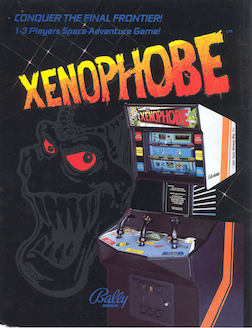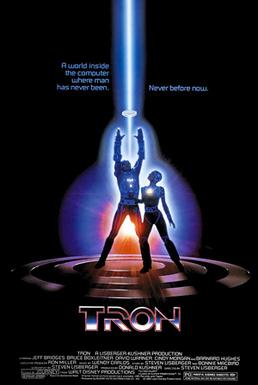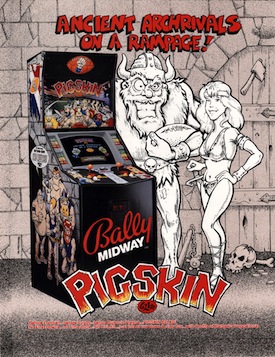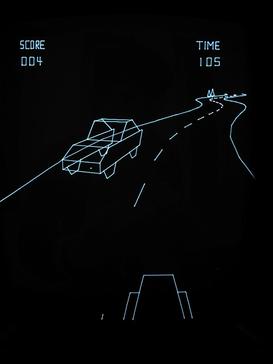
Xenophobe is a video game developed by Bally Midway and released in arcades in 1987. Starbases, moons, ships, and space cities are infested with aliens, and the players have to kill the aliens before each is completely overrun. The screen is split into three horizontally-scrolling windows, one for each of up to three players, yet all players are in the same game world.

Joust is an action game developed by Williams Electronics and released in arcades in 1982. While not the first two-player cooperative video game, Joust's success and polished implementation popularized the concept. Players assume the role of knights armed with lances and mounted on large birds, who must fly around the screen and defeat enemy knights riding buzzards.

Tron is a 1982 American science fiction action adventure film written and directed by Steven Lisberger from a story by Lisberger and Bonnie MacBird. The film stars Jeff Bridges as Kevin Flynn, a computer programmer and video game developer who is transported inside the software world of a mainframe computer where he interacts with programs in his attempt to escape; it also stars Bruce Boxleitner, David Warner, Cindy Morgan, and Barnard Hughes. Tron, along with The Last Starfighter, was one of cinema's earliest films to use extensive computer-generated imagery (CGI).
Midway Games Inc., known previously as Midway Manufacturing and Bally Midway, and commonly known as simply Midway, was an American video game developer and publisher. Midway's franchises included Mortal Kombat, Rampage, Spy Hunter, NBA Jam, Cruis'n, and NFL Blitz. Midway also acquired the rights to video games that were originally developed by Williams Electronics and Atari Games, such as Defender, Joust, Robotron: 2084, Gauntlet, and the Rush series.

Discs of Tron is the second arcade video game based on the 1982 Disney film Tron. While the first Tron is a collection of four minigames, Discs of Tron is a single game inspired by Tron's disc-battles. It is set in an arena similar to the one in the jai alai–style sequence.

Pac-Land is a 1984 side-scrolling arcade platform game developed and released by Namco. It was distributed in North America by Bally Midway, and in Europe by Atari Games. Controlling Pac-Man, the player must make it to the end of each stage to return a lost fairy back to its home in Fairyland. Pac-Man will need to avoid obstacles, such as falling logs and water-spewing fire hydrants, alongside his enemies, the Ghost Gang. Eating large flashing Power Pellets will cause the ghosts to turn blue, allowing Pac-Man to eat them for points.

WMS Industries, Inc. was an American electronic gaming and amusement manufacturer in Enterprise, Nevada. It was merged into Scientific Games in 2016. WMS's predecessor was the Williams Manufacturing Company, founded in 1943 by Harry E. Williams. However, the company that became WMS Industries was formally founded in 1974 as Williams Electronics, Inc.
The golden age of arcade video games was the period of rapid growth, technological development, and cultural influence of arcade video games from the late 1970s to the early 1980s. The release of Space Invaders in 1978 led to a wave of shoot-'em-up games such as Galaxian and the vector graphics-based Asteroids in 1979, made possible by new computing technology that had greater power and lower costs. Arcade video games switched from black-and-white to color, with titles such as Frogger and Centipede taking advantage of the visual opportunities of bright palettes.

Tron is a coin-operated arcade video game manufactured and distributed by Bally Midway in 1982. The game consists of four subgames inspired by the events of the Walt Disney Productions motion picture Tron released earlier in the summer. The lead programmer was Bill Adams. The music programmer was Earl Vickers.

Rampage is a 1986 arcade video game by Bally Midway. Inspired by monster films, players control a trio of monsters: George, Lizzie, and Ralph, humans turned into creatures due to various experimental mishaps. The objective is to destroy cities and combat military forces while maintaining their health. The game is set across 128 days in cities across North America, with each cycle repeating five times. Gameplay includes destroying buildings, eating humans, and avoiding damage.

Gun Fight, known as Western Gun in Japan and Europe, is a 1975 multidirectional shooter arcade video game designed by Tomohiro Nishikado, and released by Taito in Japan and Europe and by Midway in North America. Based around two Old West cowboys armed with revolvers and squaring off in a duel, it was the first video game to depict human-to-human combat. The Midway version was also the first video game to use a microprocessor instead of TTL. The game's concept was adapted from Sega's 1969 arcade electro-mechanical game Gun Fight.

Pigskin 621 A.D. is an arcade game released in 1990 by Midway Manufacturing under the "Bally Midway" label. One player can battle the computer, or two players can battle head-to-head. Two teams compete to score as many touchdowns as possible in the tradition of American football, but actual play is more similar to rugby football.
The following article is a broad timeline of arcade video games.

Arch Rivals is a basketball video game released by Midway for arcades in 1989. Billed by Midway as "A Basket Brawl", the game features two-on-two full court basketball games in which players are encouraged to punch opposing players and steal the ball from them. Arch Rivals was the second basketball video game released by Midway, sixteen years after TV Basketball (1974). Home versions of the game were released for the Nintendo Entertainment System, Genesis/Mega Drive, and Game Gear.

Rampage World Tour is an arcade video game released by Midway in 1997 as the sequel to Rampage. It was developed at Game Refuge by Brian Colin and Jeff Nauman, who designed the 1986 original. Ports were released for the Sega Saturn, Nintendo 64, Game Boy Color, PlayStation, and Microsoft Windows. It was re-released on Midway Arcade Treasures 2 and included in Rampage: Total Destruction.
David Judd Nutting was an industrial design engineer who played a role in the early video game industry. He also designed the exterior of the Jeep Wagoneer.

Speed Freak is a monochrome vector arcade game created by Vectorbeam in 1979. Along with Atari, Inc.'s Night Driver and Bally Midway's Datsun 280 ZZZAP–both from 1976–it is one of the earliest first-person driving games and the first such game known to use vector graphics.

George Gomez is an industrial designer, video game designer, and pinball designer who has worked for Bally, Williams, and Stern Pinball, among other companies. He has designed or contributed to several notable games, including Tron (1982), NBA Fastbreak (1997), and Monster Bash (1998).
Electro-mechanical games are types of arcade games that operate on a combination of some electronic circuitry and mechanical actions from the player to move items contained within the game's cabinet. Some of these were early light gun games using light-sensitive sensors on targets to register hits, while others were simulation games such as driving games, combat flight simulators and sports games. EM games were popular in amusement arcades from the late 1940s up until the 1970s, serving as alternatives to pinball machines, which had been stigmatized as games of chance during that period. EM games lost popularity in the 1970s, as arcade video games had emerged to replace them in addition to newer pinball machines designed as games of skill.
Game Refuge Inc. is an independent video-game developer with offices in Downers Grove, Illinois. It was founded in 1992 by Brian Colin and Jeff Nauman, the creators of Rampage, Arch Rivals and many other arcade games for Bally/Midway. The company has developed over 45 games for a variety of platforms, including consoles, PCs, arcades, touchscreen countertop machines, casino gaming, mobile devices and Facebook.













